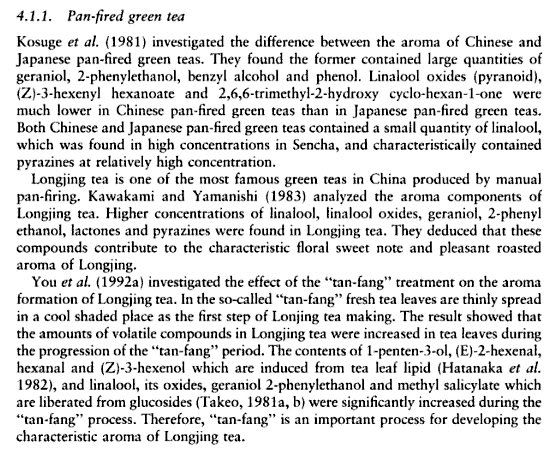Earl grey needs bergamot oil - its the fundamental character of the tea. If you examine bergamot essential oils, you gots your limonene (a lot of it), but you also gots your linalool light oils, too:".
http://www.bojensen.net/EssentialOilsEn ... Oils04.htm
One of the worlds most desirable teas, Longjing, has a sweet, floral fragrance associated with linalool. Linalool is a volatile oil that concentrates when the tea is allowed to naturally 'ferment' in cool shady area.

Green teas from Japan also have a higher natural abundance of linalool esters. Green teas and Earl Grey have something in common - they both abate stress effects in humans when consumed as hot teas.
Linalool has been shown to modulate the stress response in humans: research indicates that inhalation attenuates stress-induced changes in important immune cells of blood, by changing gene expression.
Stress Repression in Restrained Rats by (R)-(−)-Linalool Inhalation and Gene Expression Profiling of Their Whole Blood Cells. J. Agric. Food Chem., 2009, 57 (12), pp 5480–5485.
http://pubs.acs.org/doi/abs/10.1021/jf900420g
That is "a very good thing", as Martha would say. Stress tends to hamper the immune system.
Now we go back the light bending bit I mentioned earlier. Linalool and its derivatives associated with bergamot flavor and its biological effect as a stress reducer, comes in two forms, called 'enantiomers'. Like your hands, they look alike, but can't be stacked one on another. One enantiomer bends light to the right, and the other bends it to the left.
http://www.leffingwell.com/chirality/ci ... oid%29.htm
The one we want, the right-bending molecule (ironically, the image is on the left side of the webpage), is associated with a sweet, creamy floral fragrance. The other one is earthy.
If you use a cheapo industrial version of bergamot oil, its a combination of the two. The lefty (earthy smelling) version effectively cancels binding of the righty tighty version. So you get a muddy flavor and very little beneficial stress-fighting effect.
You need natural oils (the righty is made preferentially) and you want to add to a good quality pan fired Chinese Green or to a steamed Japanese Green.
And you want to add *during tea leaf processing*, if possible. You don't need much, you want it to concentrate with the natural limonene and linalool content, just to boost it a bit, not overwhelm the natural nose of these teas. If you coat the outside of the tea too much, its overwhelming, and you can swamp the olfactory system, effectively shutting off the good part of smelling it.
That is how you make a better Earl Grey. If you add the scent to a cheap black tea, with a non floral 'nose', as a cheap industrial essential oil, it is (a) overwhelmingly too much scent (b) out of place because its not normally present in most black teas and (c) muddy due to mixed enantiomer forms being present.
An exception to the "just say no to black teas' might be a better Darjeeling as your base tea. Geraniol and linalool are key components of darjeelings.
http://www.thedarjeelingtealady.com/tea/?cat=4
http://chadao.blogspot.com/2007/03/role ... h-and.html
http://www.thedarjeelingtealady.com/tea/?cat=4
Sorry, I don't 'do' videos.